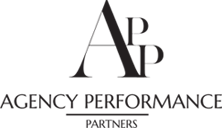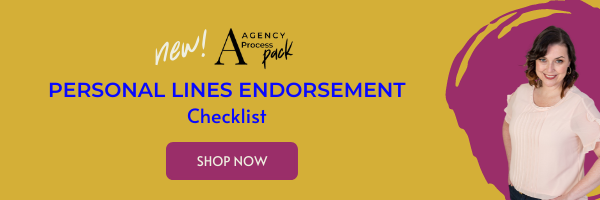Personal Lines Endorsement Checklists: Protection Against E&O Claims
Learn why you need to protect your agency against potential Errors & Omissions suits with best practices, including Personal Lines Endorsement Checklists. Don’t leave things to chance!
Anytime there’s a catastrophic weather event or a natural disaster, errors and omissions (E&O) claims follow, alleging things that you or your staff did or didn’t do to protect your clients. In a think-piece entitled Are Brokers in for a Tsunami of Pandemic-Related E&O Claims in 2021?, specialty insurance distributor AmWins says that “… there is generally a 12 to 24-month lag time from when the exposure occurred to when E&O claims are filed, and that it is not uncommon for the industry to experience a surge in E&O allegations against brokers several months or even a year or more after a catastrophic event.”
We can expect a similar pattern to occur post-pandemic, with some key differences. First, weather-related events are usually geographically confined, while the pandemic hit the entire nation to a greater or lesser extent; second, personal lines such as home and auto insurance may be less of a target than commercial insurance, which is inundated with business interruption disputes, among other claims.
While it’s expected that most E&O claims will happen on the commercial side, there will no doubt be some activity in personal lines. Think about failure to renew coverage or to process claims in a timely fashion. Or someone conducting business from home during the pandemic may fault you for not having suggested a business endorsement to their home insurance policy for a loss that exceeds their homeowners’ coverage limits. And although most E&O claims are filed by clients, insurance companies can also allege wrongdoing and sue your agency. Insurance carrier E&O suits generally represent 5 to 10 percent of all E&O claims against agents.
Regardless of the particulars surrounding the pandemic, the important lesson is this: Every day holds the potential for an E&O claim against your agency, and every catastrophe holds the potential for an E&O claim spike in the year that follows. How do you mitigate that exposure?
In Will Agency E&O Claims Be The ‘Next Wave’ of COVID-19?, Dave Hulcher, executive director of the Kansas Association of Insurance Agents (KAIA), says:
When you look at trying to protect yourself and your agency, we always talk about document, document, document,” Hulcher says. “There’s no way of talking about E&O and risk management without saying that.” And that also includes documentation with the underwriter as well.
We couldn’t agree more with that observation, and in thinking of documentation, endorsement checklists can be one of your best friends. Let’s dig a little deeper on your personal lines E&O exposures and what you can do to manage and reduce your risks.
Why E&O Lawsuits Occur
The first step in protecting yourself against E&O claims is having proper E&O insurance coverage. This coverage is essentially a type of professional liability that protects you, your agency, and your staff members against actual or alleged failures, negligence, and actions that you did or didn’t take. It helps you cover legal costs and cover settlements up to the coverage limits of your policy. E&O coverage policies are written on a “claims made” basis so there is no retroactive coverage, your policy must be in force when the event happened and the claim occurred. Unsurprisingly, illegal and intentional events are excluded, as is coverage for any independent contractors.
According to the National Association of Professional Agents (NAPA) and member research conducted by the Independent Insurance Agents & Brokers of America (IIABA), failure to procure coverage accounted for 24 percent of all E&O claims filed against independent property & casualty agents.
Other common reasons why claims were filed against property & casualty agents include:
- Failing to adequately explain policy provisions
- Failing to adequately identify exposures
- Failing to recommend appropriate or adequate coverage
- Sending faulty, inaccurate, or incomplete client information to an insurer
- Failing to provide timely notice of a claim to the insurer
In our experience working with hundreds of agencies across the nation, we have seen that the failure to offer, explain, and document endorsements represents one of the biggest exposures in personal lines insurance. As well as the inherent risk in this failure, it’s also a missed opportunity for your agency to grow and your client to boost protection.
The Scoop on Insurance Endorsements
According to the National Association of Insurance Commissioners (NAIC):
“An insurance endorsement /rider is an amendment to an existing insurance contract that changes the terms of the original policy. An endorsement/rider can be issued at the time of purchase, mid-term, or at renewal time. Insurance premiums may be affected and adjusted as a result.”
Endorsements can be added to make changes in homeowner’s and renter’s policies, auto insurance coverage, and life insurance. An endorsement/rider alters the policy and becomes part of your legal insurance agreement, and it remains in force until the contract expires. While many endorsements are commonly available, variations can occur by state, by type of insurance, and by insurer.
While the terms “rider” and “endorsement” are synonymous, there is a common misconception that a “floater” is also a synonym. Not so, a floater is a more specific policy add-on that increases or extends coverage to a specified item, such as an expensive piece of jewelry, fur, or a musical instrument.
Here are some of the reasons why a policy might be amended with an endorsement:
- To increase standard limits of coverage.
- To add or delete people and locations to your current insurance policy.
- To exclude coverage for certain types of claims.
- To cover perils not originally listed as covered in the policy.
- To tailor coverage to a client’s specific circumstances.
Common Home Insurance Endorsements
State coverage laws vary. These coverages are frequently offered via endorsement, but in some cases, maybe packaged in your basic coverage or required as stand-alone policies depending on your location and insurance company. These are some of the more common endorsements, but the list is not exhaustive – some carriers will offer others.
- Water backup, sewer backup, and sump discharge or overflow
- Earthquake, landslides, and sinkholes
- Flood
- Costly personal items, such as jewelry, antiques, and collections. A policy will cover items up to the policy limits, but expensive jewelry and collections should be covered with an endorsement, a floater, or in some cases, a separate policy.
- Identity theft
- Cybersecurity
- Home businesses
- Inflation guard
- Personal injury – covering slander, defamation, and non-body injuries
- Extended replacement cost coverage
- Food spoilage
- Service line coverage
- Equipment breakdown coverage
- Secondary residence premises
Common Auto Insurance Endorsements
Again, state coverage laws vary. These coverages are frequently offered via endorsement, but in some cases, maybe packaged in your basic coverage or required as stand-alone policies depending on your location and insurance company. These are some of the more common endorsements, but the list is not exhaustive – some carriers will offer others.
- GAP insurance – when your auto loan on a new car is greater than the depreciated value, this covers the gap if your car is stolen or totaled.
- Rideshare – personal auto insurance typically doesn’t cover the “business use” of a vehicle.
- Rental coverage or reimbursement
- Classic or collector car
- Roadside assistance and towing
- Accident forgiveness
Best Practices for Reducing Your E&O Exposure
Watch for life changes: You need to be alert for changes in your insureds life circumstances and educate them about communicating life changes to you. That means account reviews and periodic communications, both outgoing and incoming. It also calls for a systematic, organized, detailed way to track and process endorsements, including a paper trail. Why? Failure to alert or explain coverage options to an insured is one of the biggest reasons for an Errors & Omissions claim and a potential lawsuit.
Here are some common events that should prompt a coverage discussion:
- Marriage or divorce
- Birth or adoption of a child
- Death of an immediate family member
- Purchasing a new home, condo, a second home, downsizing, or moving to a new apartment or a new city/town/state
- Home renovations or adding buildings to your property
- Renting out your home
- Getting a new car
- A teen child getting an auto license or going to a remote college
- Joining a carpool
- Acquiring expensive electronics, antiques, jewelry, furs, or specialty collections
- Acquiring a recreational vehicle – RV, motorcycle, snowmobile, or utility trailer
- Getting a boat or watercraft
- Getting a recreational drone
- Changing jobs and job benefits
- Retiring
- Starting a home business or a small business
- Joining the sharing economy, such as renting property or driving for Uber
- Military deployment
Communicate and educate clients on an ongoing basis through various communication media: The most important step that you can take to reduce your exposure to E&O claims is to stay in frequent communication with your insureds and to provide educational content. Teach your clients to think about calling you to re-assess insurance coverage when any major life changes occur. Provide scripts to your service staff on eliciting such information conversationally. Issue periodic email reminders to home and auto insureds with tips and reminders. Follow your clients on social media and get them to follow you. Post periodic reminders about life events that should trigger a call to change coverage and seasonal insurance-related tips.
Communicate with a service ethic and sales will follow. All too often, service people shy away from selling or having discussions that seem sales-related. Providing information that will reduce your client’s risks is one of the key services that you provide. You are the expert that understands risks and exposures, that is one of the primary reasons clients are seeking your help rather than buying directly online. Explaining and quoting coverage options is a service. Discuss the pros and cons and leave the decision to them. Your clients will appreciate it.
Process policy change requests as soon as possible. Whether via an incoming request or an outgoing call that elicits the need, act as expeditiously as you can. This requires a process. Whenever possible, process that change or request in real-time while the client is on the phone. If you are waiting for a client decision or a quote, set deadlines and expectations for follow-up. Make notes in your agency management system and set reminders and alerts. If the change involves a change in premium, alert your client to this via text or email to keep a paper trail.
Communication is a two-way process. It’s not just whether you convey a message, it’s whether the message was received and understood. Insurance is confusing to people who do not work with it every day. Avoid lingo, jargon, and acronyms. Don’t assume understanding, probe. Make it easy for people to ask questions. This is as true for commercial insurance as personal insurance. It’s easy to assume that a company principal or CFO knows details about insurance. While that is sometimes true, it is not a given.
Document, document, document. There is no such thing as too much documentation. The one-to-one personal interaction of phone and in-person conversations is great, but it is essential to follow up in writing with a summary of key points so that you have a documented process. Don’t rely on memory. Note all client interactions and decisions in your client log.
Don’t step in the insurer’s shoes. When a client is filing a claim or inquiring about specific coverage related to a claim, be careful about getting between your client and their insurer and interpreting whether they’ll be covered. Stay factual, provide support, but not opinions. Let the insurer determine coverage. Never discourage them from submitting a claim.
If an E&O claim occurs … Despite your best intentions, bad things can happen to good people. If you learn of an E&O claim, real or potential, be professional and don’t argue with the client, admit fault, or try to make it go away. Whether it is an actual claim or just a potential one, notify your E&O insurer immediately. Be prepared to provide background information and thorough documentation. Get guidance from your E&O insurer or your attorney. Next, stop talking about the claim – to the client, to the insurance carrier of the coverage, to anyone beyond the need-to-know circle. You know how smart people on TV news, legal dramas, and films respond to seemingly simple questions with a reply like, “because this is under litigation, I am not free to discuss?” That. Work with your attorney or E&O carrier to develop an appropriate response along those lines. Don’t exacerbate a problem via talk.
Why Are Insurance Endorsement Checklists so Important?
It is of vital importance that you help your client understand common gaps and exposures in their personal coverage and offer them potential solutions. They may weigh the risk/value and decide against it but as an agent, you have fulfilled your duty to advise them. Checklists provide a process to ensure that you run through potential gaps in coverage that could leave a client exposed. They also provide a documented paper trail that tracks the discussion and the subsequent client decision, offering a ready defense, should one be required
How Personal Lines Endorsement Checklists Can Reduce Your E&O Exposure
Decrease your exposure to E&O claims and increase your client satisfaction by investing in a plan to give your team a structure to reduce errors and boost the customer experience. We’ve got you covered with a disciplined, easy-to-follow path for every detail of an auto or home insurance endorsement. For your agency’s painless, out-of-the-box plan, check out our Agency Process Pack – Auto Insurance Endorsements & Home Insurance Endorsements Checklists. Find templates, videos, and the sample scripts your agency needs to promote and process personal insurance endorsements.
What’s included in the Endorsements Checklists Process Pack?
- Mini E-course with best practices
- Workbooks that review auto and home insurance endorsement strategies
- Videos that explain the checklists
- Both auto and home insurance Endorsement Checklists as Word documents and fillable PDFs that can be customized to your agency
- Converting Endorsement into opportunities
- Processing Checklist
- Scripts to guide your team on the process
Check out our other Agency Process Packs.




